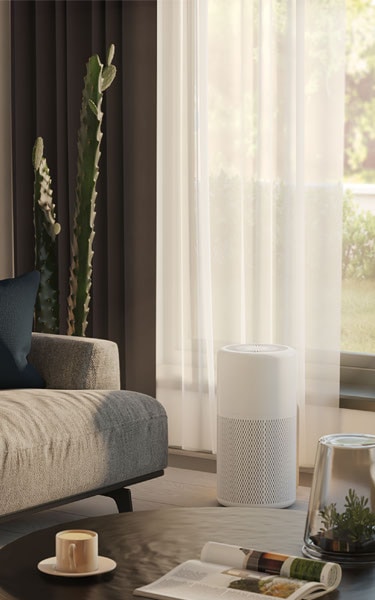Air purifiers fundamentally sanitise the air that might contain contaminants, toxins, and allergens. Humidifiers and essential oil diffusers that add particles to indoor air are the polar opposite of these devices. Filters and air purifiers work in different ways. Purifiers can also sterilise particles, whereas filters only remove them.
With several people now spending longer hours increasingly indoors either studying or working, it's more vital than ever to consider the quality of the indoor environment and how we can create cleaner, healthier surroundings at home. And here's where air purifiers come in handy.
What is an air purifier?
An air purifier is a machine that eliminates pollutants from the indoor air and enhances the air quality leaving the indoor environment clean and contaminant-free.
What does an air purifier actually do?
An air purifier removes contaminants from a room's air to enhance the quality of the air. Pollen, pesticides, dust, ragweed, pet dander, dust mites, mildew, paint fumes, and second-hand smoke are just a few of the toxins that the air purifier filters. Allergy patients, asthmatics, and anyone with an impaired respiratory system may experience minor to major health problems because of these particles.
Air purifiers fundamentally sanitise the air that might contain contaminants, toxins, and allergens. Humidifiers and essential oil diffusers that add particles to indoor air are the polar opposite of these devices. Filters and air purifiers work in different ways. Purifiers can also sterilise particles, whereas filters only remove them.
How does an air purifier work?
An air purifier is a device that cleans the air by removing airborne pollutants and allergens that are even invisible to the naked eye. Air purifiers use filtration and advanced air cleansing technologies to accomplish this. The type of air purifier and filter chosen determines which airborne particles are removed from the air. Filters used in certain variants are meant for trapping air pollutants as air passes through them, while other variants may neutralise harmful particles in the air without screening them first. Apart from a single or numerous filters, an air purifier also consists of a fan that draws in and circulates air.
Every air purifier is diverse, so if you're pondering the purpose of an air purifier, you'll first need to understand more about its working. The type of filtering technology you choose will determine which particles are eliminated by an air purifier. There are four main methods in which air purifiers work:
- HEPA Filter - This is an air filter to collect solid particles. The HEPA filter works by sucking air into a dense, woven filter and capturing particles within, thereby preventing them from floating back into the atmosphere. It can collect 99.97% of particles as small as 0.3 microns.
- Ioniser - Using an electrical charge to neutralise air pollutants. It can take one of two forms:
- Releasing negatively charged ions into the atmosphere, which cling to pollutants. Due to this bond, these air pollutants adhere to surrounding surfaces and fall to the ground.
- Air is drawn through the unit, and pollutants are collected on a series of charged metal rods or plates. This works the same way as an air filter, except pollutants get attached to the material's surface, and the plates must be washed clean.
- Activated Carbon - Using activated carbon to trap odour molecules. An activated carbon filter operates by capturing odour-producing molecules within the household. VOCs (volatile organic compounds) and other gaseous contaminants are also removed by this filter. This air filter can only absorb chemical vapours. This is unachievable with a HEPA filter since it only absorbs solid particles.
- UV Light - Breaking apart pollutants. This air-purifying technique works by emitting a non-lethal form of radiation through a light inside the unit, which destroys viruses and bacteria as they flow through the machine. To render pathogens and microbes harmless to your health, UV light breaks down their molecular structure.
Benefits of an air purifier
An air purifier can purify the air from a wide variety of pollutants and allergens that can be hard on an individual's health in the long term. Air purifier benefits extend beyond simply purifying the air from regular pollutants.
Uses of an air purifier against dust
Pollutants like dust, which is more typically found in houses than elsewhere, are far more likely to be trapped in spaces with poor ventilation. Despite its appearance as a simple irritant, dust attracts mites, pathogens, and viruses, all of which can cause allergic reactions in people with acute respiratory illnesses. That's because the body reacts to pollen, dust, etc., by releasing IgE, an allergy antibody. As a result, allergic symptoms such as sneezing, wheezing, rashes, and others occur.
An air purifier removes these airborne particles from the indoor air to prevent these reactions and help prevent illnesses and other health issues.
Uses of an air purifier against allergens
Apart from dust, other allergens like pollen and much more can cause allergic reactions in the body by producing IgE antibodies. An air purifier will filter these impurities by employing the filters setup inside the device. Common airborne diseases like the flu or common cold can be prevented from spreading throughout a household if an air purifier is around. A scientific study recognised air purifiers as the fourth most effective method to prevent asthma attacks.
Uses of an air purifier against pet hair
Pets lose hair and dander and emit odour, putting children and other family members in danger of inhaling particulate-laden air. If the pet is not groomed regularly, the condition can exacerbate. When this impure air enters the body, it may provoke allergies and lead to health problems in the future. Investing in a good air purifier to eradicate hazardous airborne particles should be one of the first things on the to-do list to live in harmony with your pets.
Uses of an air purifier against bad odour and smells
Investing in an air purifier could be a long-term solution if your residence or the surrounding region smells, has unpleasant odours, is prone to bushfires or even if one of the family members is a smoker. Chronic obstructive pulmonary disease (COPD) and heart disease can both be caused by inhaling cigarette smoke. Since a child's lungs are developing continuously and are at a more nascent stage in respiratory rate than an adult, second-hand tobacco smoke or any other smoke is just as harmful. Meanwhile, elderly adults who are susceptible to passive smoking have an increased risk of developing dementia.
Smoke can be removed from the indoor air by using an air purifier with a HEPA filter or an activated carbon mechanism. Air purification through a good air purifier makes the indoor environment pleasant with fresh and clean air by eliminating unpleasant odours, smoke and more. Thus, an air purifier helps both in air-freshening and air purification in this case.
Uses of an air purifier against mould
Humidity, water or flooding damage make an ideal breeding ground for potentially harmful mould to grow if left unattended. Although air purifiers cannot physically eliminate the mould growing on carpets and walls, air purifiers containing HEPA filters or activated carbon can effectively eliminate minute airborne mould spores. Not just the spores but mould odours can be neutralised using air purifiers with carbon filters.
Frequently Asked Questions
How frequently should the filters in an air purifier be changed?
The air purifier fan draws in air and pushes it via a filter that catches big harmful particles like allergens, dust, pollutants, and irritants. If these filters become clogged with dust, grime, and other build-up they lose effectiveness, making the air filtration system far less effective.
Depending on air quality and environmental factors, the maximum span a HEPA filter should be used is 6-12 months, whereas the Carbon pre-filters should not be used for more than three months.
But for enhanced efficiency, changing filters every 3-6 months is advised. Asthma and allergy patients, along with those seeking a healthier environment with fresh and clean air, should replace their filters every 30-60 days.
Do air purifiers dry out the air?
No, an air purifier cannot provide moisture to the air or eliminate it. Unlike a dehumidifier, an air purifier does not absorb moisture from the air. It is a device that traps air contaminants such as dirt, dust mites, pet dander, mildew, and other allergens. It draws in the air with the help of a fan or ionisers and then diffuses it back into the indoor environment after filtering and eliminating any harmful particles. Therefore, it has no effect on the moisture or humidity levels in the air.
Browse our range of air purifiers.





